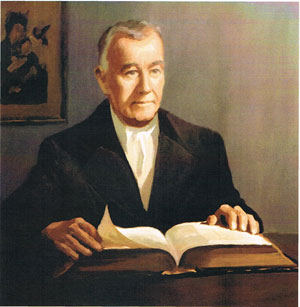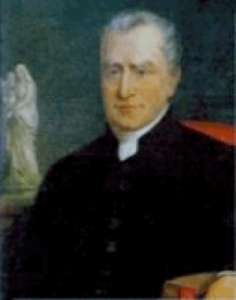Who was Blessed Edmund Rice?

Born in Callan, Ireland, in 1762, Edmund came to the bustling city port of Waterford as a young man. He was talented, energetic and soon became very wealthy. Married to Mary Elliot, in 1789 he experienced her tragic death soon after she gave birth to their daughter Mary. Deeply saddened by her loss, Edmund entered a time of mourning. In his own brokenness, he was moved with compassion to recognise the brokenness of those around him. He realised that Jesus’ call to liberation is at the heart of what Jesus preached and in which his church is engaged.
The Ireland of Edmund’s day was an unjust place where many lived in poverty and social structures deeply oppressed the majority of the population. In 1802, he set up a free school for poor boys. His aim was to promote an education that recognised the dignity of each individual and thus he sought to liberate them from their ignorance of God and of their Catholic faith. At the same time he sought to empower them with an education which would enable them to rise from the demeaning poverty and sense of hopelessness. Thus, Edmund sought to liberate individuals and indeed to free his society from oppression.
The Beginnings
Ireland in 1762 was under British rule and the anti-Catholic Penal Laws, were in force. These laws prevented a Catholic from owning land over a certain value, owning a weapon, from attending Mass in public and from receiving an education. “The laws of Ireland did not presume a Roman Catholic to exist.” The Penal Laws severely limited the career prospects of Catholics. Opportunities were limited to farming, emigration, religious life or commerce and business. These laws were relaxed at the time of Edmund’s childhood and were eventually dropped in 1829. As a result of the Penal Laws, Edmund was forced to receive his primary school education from a “hedge school”. These were illegal schools established by travelling teachers, usually only one teacher was in each school. Edmund’s parents provided his religious education. Edmund later attended a commercial academy in which prepared him for his future business career. Generally, he received a limited education.


In 1779, Edmund began an apprenticeship with his uncle. Michael Rice, who owned a very successful merchant trading business in Waterford city. Waterford was the second busiest shipping port in the world at the time. Michael died in 1785, and the business was passed into Edmund’s ownership. In 1787, Edmund married the young daughter of a Waterford tanner, believed to be Mary Elliott. The marriage was short due to Mary’s untimely death in 1789. The baby she was carrying was saved and was christened, Mary. Edmund, due to his immense grief and business commitments, invited his spinster step sister, Joan (Murphy) to be housekeeper for him and to share the parenting of young Mary.
Spirituality
We know precious little about Edmund Rice and both his spirituality and educational philosophy from what he wrote. A practical man, a business man, Edmund’s letters were often about business and the day to day affairs that he engaged in. But what we do know from the oral tradition passed down is that Edmund was a deeply spiritual man. Edmund was a daily Mass goer in Waterford and he wrote all of his important letters in the presence of the Blessed Sacrament. He founded a Religious Order which later became the Congregation of Christian Brothers. In 1808, he took the Religious name ‘Ignatius’. This choice was no surprise as Edmund had had a local Jesuit priest as his spiritual director. Early paintings of Edmund show his hand placed on a copy of the Bible. Edmund owned his own Bible which was a rare feat for a layman in late eighteenth century Ireland. Not only did Edmund own his own copy of the Bible but he used it for reflection often. Edmund wrote and made notes in many places in his Bible and these notes and reflections are all concerned with usury and economic justice for the poor. Edmund Rice had a deep intimate faith in Jesus. A deeply reflective man, Edmund had a deep devotion to Mary the mother of Jesus and would often be seen praying the rosary.
Edmund’s spirituality is characterised by a simple but profound trust in God. Edmund said often, “Providence is our inheritance!” Many of his letters invite the recipient to turn to God and trust in God in times of hardship.

Edmund was given the grace to respond to the call of Jesus by identifying with Christ in the poor. His example evoked a deep awareness of God’s loving presence in all. He invited his followers to share the Gospel insight to reach out to the needy. The Christian Brothers reflecting on the special Gospel Insight [charism] of Edmund Rice in 1982 named Edmund’s charism as “Edmund Rice was moved by the Holy Spirit to open his whole heart to Christ present and appealing to him in the poor.”
‘Be intent on prayer and whatever may happen will turn to good. Cast all your cares into the arms of Divine Providence.’ Edmund Rice.
In 1797, the then Bishop of Waterford, Dr Hussey, published a Pastoral letter which encouraged the establishment of Catholic schools for the poor. Any spare diocesan money was to be used for this purpose. In November 1798, two Presentation Sisters of the order founded by Nano Nagle in 1775, opened a school for girls in Waterford. Edmund helped them to build a school and convent. It was suggested to Edmund that he do something similar for the poor boys of Waterford.
Edmund wound up his business and opened his first school at Waterford in 1802. He placed unbounded trust in Providence and in his own words said - ‘Be intent on prayer and whatever may happen will turn to good. Cast all your cares into the arms of Divine Providence.’
Edmund wished to improve the status of poor boys through education and in particular, religious education. In 1802, on a property originally owned by his wife, a makeshift school was established in a converted stable in New Street, Waterford. It had three rooms and he lived in the attic. Edmund was 40 years old.

The Ministry
Edmund found the children in his school were difficult to manage and it was hard to retain teachers to assist him. His trust in providence was rewarded with the arrival of two young educators, Thomas Grosvenor and Patrick Finn, from his home town of Callan. They began to assist school operations.
Edmund had no background in education. He had limited education himself, however he looked around at the current educational methods to teach large numbers of children. Very quickly Edmund developed a system where one teacher, maybe assisted by a monitor, could teach up to 150 children in a single class in 1810. Edmund produced a manual in which he laid down the way his schools were to operate. Boys were grouped not according to their age, but according to their educational attainment (radical for that time).
Edmund was also quite adamant that boys would not be punished physically. Again this was contrary to behaviour management in that era. This manual was extremely directive and prescriptive to the way in which classes and schools would be conducted.
The subsequent success of the New Street school led to more permanent buildings being built on a nearby purchased property overlooking Waterford. This school was named Mt Sion and construction began on 1 June, 1802. The Mt Sion Brother’s residence was officially blessed by Bishop Hussey on 7 June, 1803.
From the outset, it was clear that education for poor boys could only be provided once other more basic needs had been met. Consequently Edmund set up a bakery and tailor shop to help provide the basic necessities of food and clothing. He turned to his friends of his business days to secure financial assistance for this project. The generosity of the local community was significant.
On the 1 May 1804, the Mt Sion school was officially opened and blessed by the new Bishop, Dr John Power, a good friend of Edmund. By 1807, three schools including Brothers’ residences were in existence at Mt Sion, Dungarvan and Carrick-on-Suir.
